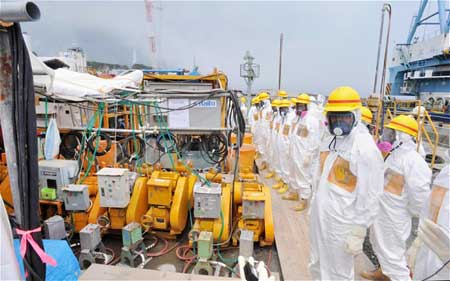
|
Japan's prime minister Thursday ordered his government to find "multiple, speedy and sure" ways to stop the spread of radioactive groundwater around the meltdown-stricken Fukushima Daiichi nuclear power plant, including freezing the surrounding ground. Prime Minister Shinzo Abe's directive comes two weeks after the Tokyo Electric Power Company admitted that contaminated water was leaching into the Pacific Ocean from the plant, the site of the worst nuclear accident in a quarter-century. "This is not an issue where we can let TEPCO take complete responsibility," Abe told reporters at the government's nuclear disaster response headquarters. "We have to deal with this at a national level." Abe said he has told Japan's Ministry of Trade and Industry to "provide multiple, speedy and sure solutions to this issue." The ministry has proposed setting up a subterranean barrier around the plant by freezing the ground around it, preventing groundwater from leaking into the damaged plant and carrying radioactive particles with it as it seeps out. The public has a strong concern over the contaminated water problem, and this is an urgent issue to solve," Abe said. "We will not leave it only to TEPCO, but will lay out firm measures." That will mean a still-undetermined amount of direct government spending to aid the ailing utility, Yoshihide Suga, Japan's chief cabinet secretary, told reporters. Building a frozen wall around the plant is "unprecedented," he said. "To build such a wall, the government should take the lead to promote this kind of project," Suga said. "We have to provide the support to do so." TEPCO, the country's largest utility, has been grappling with water issues ever since the Fukushima Daiichi plant was hit by the March 2011 earthquake and tsunami that devastated eastern Japan. Scientists who monitor radiation levels offshore have pointed to persistent high readings as evidence of an ongoing leak for more than a year, but the utility did not publicly admit the problem until late July. Vast stands of storage tanks have grown up around the plant as TEPCO tries to manage the hundreds of tons of water involved every day, and the company has built an underground barrier to prevent contaminated groundwater from reaching the sea. But it remains a difficult problem, Masayuki Ono, TEPCO's acting nuclear power chief, said earlier this week. "It's a present reality that the contaminated water is seeping out to the bay without us being able to control it," Ono said. TEPCO is also pumping hundreds of tons of water a day into the plant to cool the crippled reactors two and a half years later, though most of that fluid is recycled. The 2011 tsunami swamped the plant, located 240 km (150 miles) north of Tokyo, and knocked out power to cooling systems for the three reactors that were operating at the time. The result was the second-worst nuclear accident in history, trailing only the 1986 disaster at Chernobyl, in the former Soviet Union. Meltdowns and hydrogen explosions spewed radioactive particles across many of the surrounding towns, complicating an already historic disaster. Though no deaths have been directly attributed to the accident, tens of thousands of people from towns as far as 25 miles away have been displaced by the disaster. In July, TEPCO disclosed that water from test wells around the reactor buildings showed concentrations of radioactive tritium in one well as high as 500,000 bequerels -- a unit of radioactive intensity -- per liter of water. By comparison, Japan's maximum safe level of radioactivity in drinking water for adults is 300 bequerels per liter. Another reactor byproduct, strontium-90, has been showing up in increasing concentrations as well, said Ken Buesseler, a marine radiochemist at the Woods Hole Oceanographic Institute in the United States. Strontium-90 mimics calcium in the body, seeking out bone in animal life. Buesseler said the amount of radioactive material leaking from the plant now is a small fraction -- about one ten-thousandth -- of what poured out of the plant in the weeks following the meltdowns. But while TEPCO's admission was not news to scientists, "What's less clear to me is how much this has changed in the last month," he said. "And I think that's part of the urgency." Michael Friedlander, a former nuclear plant operator and engineer, told CNN on Tuesday that the current problem may leave TEPCO and the Japanese government with two choices sure to stoke further public anger: "You can either dump it in the ocean, or you can evaporate it." "At the end of the day, collecting 400 tons of water every single day is not a sustainable solution," he said. Federal officials allowed the Three Mile Island nuclear plant in Pennsylvania, the site of the worst American nuclear accident, to let contaminated water evaporate, Friedlander said -- but TMI was nowhere near the scale of the Fukushima disaster. "We're in uncharted territory here," he said. |
综合外国媒体8月8日报道,日本福岛第一核电站核泄漏事件愈演愈烈,每天约有数百吨受放射性污染的水流向大海。日本首相安倍晋三表示,核电站污水问题需要提升至“国家层面”解决,他要求政府采取主动措施应对紧急情况。 ***每天超过300吨污水流向大海 日本政府的原子能灾害对策总部7日公布估算结果称,福岛第一核电站每天约有超过300吨污水流向大海。日本产业经济省一位主管能源政策的官员也确认这一点。分析认为,地下水是在核电站厂区内遭受放射性污染并流出的。 估算结果显示,福岛第一核电站1至4号机组周边每天流动着约1000吨地下水,其中约400吨流入反应堆厂房地下,剩余600吨地下水中约有一半流入与厂房相连的坑道后,遭滞留在其中的高浓度污水污染,流向大海。还有约300吨地下水则是在未遭污染的情况下流向大海。 日本政府和东京电力公司正在考虑采取尽快抽取护岸附近的地下水以减少污水流出量的方法。据悉,截至明年9月,污水抽取量将达到约4万吨。日本经济产业省资源能源厅负责人表示,将在厂房内增设储罐,以暂时存放抽取的污水。 ***日政府建议构筑“冻土挡水墙” “目前,单凭东京电力公司的一己之力已经无法承担起全部责任,这一问题需要提升到国家层面进行解决。”日本首相安倍晋三要求经济产业省采取“多样的、快速的、有效的”解决措施,“公众非常关注福岛第一核电站的污水问题,此事亟需解决。我们不能把问题丢给东京电力公司,我们要制定确实有效的应对方案”。 此前,日本经济产业省曾建议冻结福岛第一核电站厂房周围的土壤,设立挡水墙阻止地下水流入。其具体实施方法为,用“冻土挡水墙”把福岛第一核电站的1至4号机组围起,挖掘约1.4公里的地面,每隔1米向排列在地下的管道注入冷却材料,令其周围土壤冻结阻止地下水的流动。日本政府认为,该方法挡水效果好、施工难度低。预计施工费用为数百亿日元。 日本内阁官房长官菅义伟表示,在福岛第一核电站周围构筑冻土挡水墙是“空前之举”。“启动这样一个大项目,政府应该带头推进,我们必须提供相应的支持。”菅义伟称,这意味着政府将伸出援手、给予拨款,而拨款的具体数目尚不得而知。 ***水样中放射性物质浓度上升 7月,日本东京电力公司公布对福岛第一核电站周围观测井的水样抽检结果。抽检结果显示,其中一口观测井的井水中检出高浓度的放射性物质氚,数值为每公升50万贝克勒尔。而根据日本饮用水的安全标准,每公升最多只能含有300贝克勒尔。此外,检测水样中另一种放射性物质锶-90的浓度在不断上升。 美国伍兹霍尔海洋研究所称,与2011年福岛第一核电站发生核泄漏事故时相比,现在核电站泄露出的放射性物质只是一小部分,约为万分之一。不过,布耶斯勒指出,“我不太清楚的是,过去一个月里放射性物质的浓度变化了多少。我认为这是造成事态紧急的部分原因”。 迈克尔•弗里德兰登曾在核电站工作,担任操作员和工程师。他认为当前态势只留给日本政府和东京电力公司两个选择,而这两个选择都会激怒民众。“只能把污水倒入海洋或者蒸发掉,毕竟每天抽取400万吨污水不是长久之策。”弗里德兰登称,美国联邦政府曾允许发生核泄漏事故的三里岛核电站蒸发受放射性污染的水,但是三里岛核事故的规模远远小于福岛核事故,“所以,我们正处于一个未知的领域”。 相关阅读 (译者 肉肉融 编辑 王琦琛) |